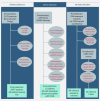Genomic study of nonsyndromic hearing loss in unaffected individuals: Frequency of pathogenic and likely pathogenic variants in a Brazilian cohort of 2,097 genomes
- PMID: 36147510
- PMCID: PMC9486813
- DOI: 10.3389/fgene.2022.921324
Genomic study of nonsyndromic hearing loss in unaffected individuals: Frequency of pathogenic and likely pathogenic variants in a Brazilian cohort of 2,097 genomes
Abstract
Hearing loss (HL) is a common sensory deficit in humans and represents an important clinical and social burden. We studied whole-genome sequencing data of a cohort of 2,097 individuals from the Brazilian Rare Genomes Project who were unaffected by hearing loss to investigate pathogenic and likely pathogenic variants associated with nonsyndromic hearing loss (NSHL). We found relevant frequencies of individuals harboring these alterations: 222 heterozygotes (10.59%) for sequence variants, 54 heterozygotes (2.58%) for copy-number variants (CNV), and four homozygotes (0.19%) for sequence variants. The top five most frequent genes and their corresponding combined allelic frequencies (AF) were GJB2 (AF = 1.57%), STRC (AF = 1%), OTOA (AF = 0.69%), TMPRSS3 (AF = 0.41%), and OTOF (AF = 0.29%). The most frequent sequence variant was GJB2:c.35del (AF = 0.72%), followed by OTOA:p. (Glu787Ter) (AF = 0.61%), while the most recurrent CNV was a microdeletion of 57.9 kb involving the STRC gene (AF = 0.91%). An important fraction of these individuals (n = 104; 4.96%) presented variants associated with autosomal dominant forms of NSHL, which may imply the development of some hearing impairment in the future. Using data from the heterozygous individuals for recessive forms and the Hardy-Weinberg equation, we estimated the population frequency of affected individuals with autosomal recessive NSHL to be 1:2,222. Considering that the overall prevalence of HL in adults ranges from 4-15% worldwide, our data indicate that an important fraction of this condition may be associated with a monogenic origin and dominant inheritance.
Keywords: GJB2 (C×26) gene mutations; STRC gene; deafness; genomics; hearing loss; nonsyndromic hearing loss; whole genome sequencing.
Copyright © 2022 Quaio, Coelho, Moura, Guedes, Chen, Ceroni, Minillo, Caraciolo, Reis, Mascaro, Nobrega, Teixeira, Martinelli, Mota, Matta, Colichio, Roncalho, Ferreira, Campilongo, Perrone, Virmond, Moreno, Prota, França, Cervato, Almeida and Oliveira.
Conflict of interest statement
The following authors are employees (received salary and other bonuses) of Hospital Israelita Albert Einstein: CQ; AC; LM; RG; KC; JC; RM; MC; RD; BA; MN; AT; ML; TM; MM; GC; AR; AF; GC; EP; LV; CM; JP; MD; MC; TA; and JO.
Figures

References
-
- Campos Coelho A. V., Cordeiro de Azevedo B. M., Lucon D. R., Nóbrega M. S., de Souza Reis R., de Alexandre R. B., et al. (2021). The Brazilian rare genomes project: validation of whole genome sequencing for rare diseases diagnosis. medRxiv 2010, 21264436. 10.1101/2021.10.01.21264436 - DOI - PMC - PubMed
LinkOut - more resources
Full Text Sources

